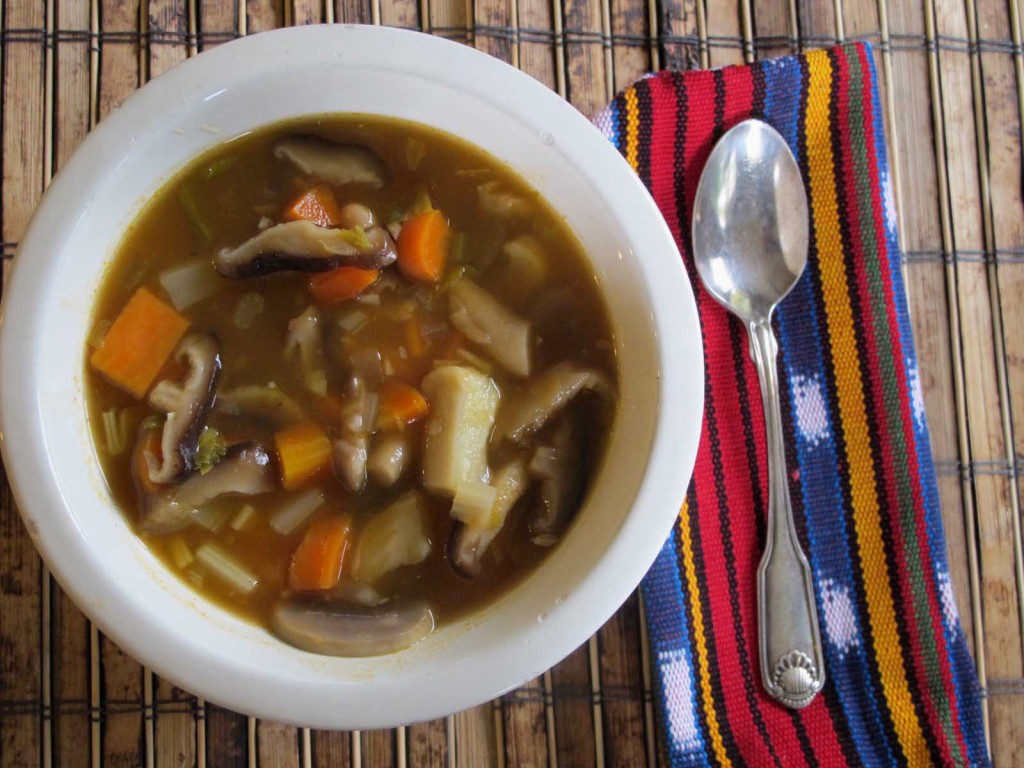This month, Diane at The W.H.O.L.E. Gang is hosting Go Ahead Honey, It’s Gluten Free. Her theme is scary foods, or foods we’re reluctant to eat because they seem weird, strange or just plain creepy. Naomi, author of the blog Straight Into Bed Cakefree, is the creative genius-ette behind GAHIGF and if you check here, you’ll see she has an exciting list of themes and hosts scheduled all the way out to June of 2011. It’s beyond my comprehension to be that organized, but those of us who enjoy all these unique flavors and creative recipes are thrilled that Naomi keeps this party going in such grand style.
Although there are lots of foods that I find scary for health reasons, I know Diane didn’t mean nasty, processed foods full of chemicals, additives and dyes, so I had to dig deep to figure out a weird food that I’d actually buy, create a recipe for and eat.
Believe it or not, mushrooms hit my “creepy food” button. I use them occasionally, but usually in a puréed form. They add a wonderful earthy taste to soups and stews, but eating them in their slimy, cooked-but-not-puréed form weirds me out. The texture is way too booger-ish.
Having said that, here’s what I like about them (other than the earthy flavor they impart). Mushrooms have been used in TCM (Traditional Chinese Medicine) for centuries for everything from immune support to anti-aging, so they’re high on the list of well-studied medicinal foods. They’re considered an adaptogen in alternative healing circles and while I doubt they’re the cure-all many tout them to be, they truly are packed with health-enhancing nutrients. Plus, they’re low in calories, so you get a lot of bang for your buck.
I usually sauté mushrooms in coconut oil and blend them with vegetable broth in my VitaMix. That way I can add them to recipes and get all the benefits and none of the icky texture. I realize most people aren’t bothered by the slimy feel of mushrooms, but I’m not one of them. So, puréeing is a good way to reap the benefits and circumvent my gag reflex.
For this recipe, I used a mix of organic shiitake, shimeiji, abalone and field mushrooms from Woodstock Farms. I didn’t sauté them first, I just tossed them into my soup blend.
mixed mushroom and veggie soup
what you need
6 cups vegetable broth (I often make my own, but this time I used Pacific organic vegetable broth)
2 cups filtered water
1 onion, diced
4 to 6 garlic cloves, minced
4 to 6 carrots, chopped
4 to 6 celery stalks with leaves, chopped
4 tomatoes, quartered and roasted
1 and 1/2 cup mixed mushrooms
oil (some for sautéing the veggies, some for coating the tomatoes)
seasonings (I used Simply Organic all-purpose seasonings)
sea salt and freshly ground pepper
what you do
1. Preheat oven to 400 degrees. Wash and quarter tomatoes. Place in bowl, drizzle with a little olive oil and sprinkle with sea salt and freshly ground pepper. Toss gently. Place skin side down on a cookie sheet and place in oven for about 30 minutes.
2. While the tomatoes are roasting, heat a glug of the oil in a heavy soup pan. Add the onions and cook for 4 to 6 minutes. Add the garlic, celery and carrots and cook for a few more minutes, stirring often.
3. Add the vegetable broth and simmer on low for about two hours.
4. Place the tomatoes (be careful blending if they’re still hot) and the filtered water in a blender and blend well. Pour into the soup mix.
5. Once the veggies are cooked, but still slightly crunchy, add the mushrooms and cook for another hour or so.
6. Add seasonings (an herb blend) and salt and pepper. Simmer for a few more minutes. Serve with gluten-free corn bread.
Peace, joy and mushroom love.
Melissa
Posted in Gluten-Free Recipes, Nutrition Therapy | 18 Comments »

















